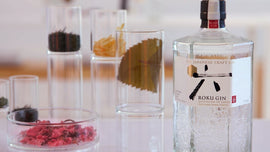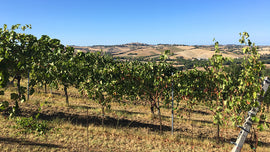Even as subtle as the change of seasons can be in Northern California, there are definite signals that indicate Summer is ending. The shorter hours of daylight, the beautiful golden light at sunset, the smell of fallen leaves all have my organoleptic senses twitching. But before I transition to the braises and stews that Fall and Winter invite, and dive into the rich, bold reds and whites that go along with them, I find I can prolong the brightness of Summer with wine. A sip of Beaujolais can elicit thoughts of picnics by the lake, and an aromatic Fiano brings back memories of seafood dinners along the Amalfi Coast. It’s inevitable that seasons will change but isn’t it wonderful that wine can alter reality for us (hopefully without a hangover) if we allow it to?
2017 Pietracupa Fiano di Avellino
Campania is the ‘shin' of Italy's boot, anchored by its capital, Naples. Its name comes from Campania felix, a Latin phrase roughly meaning 'happy land or fertile countryside'. Originally colonized by ancient Greeks, Campania is deeply rooted in culture, especially gastronomy, music, and architecture. The region is also rich in archaeology and is home to famous ancient sites such as Pompeii, Herculaneum, Paestum, and Velia.
Campania has historical links to wine and vines dating back to the 12th century BC, and is one of Italy's very oldest wine regions, with considerable influence from ancient empires, including the Greeks, Romans and Byzantines. Grapes like the region due to its abundance of sunshine, hot and dry summers, mild winters, volcanic soil, and cool winds from the Tyrrhenian Sea and the Appenine Mountains. Like many Italian regions, Campania is home to an impressive array of grape varieties, some of which are found almost nowhere else on earth. Eruptions of Mount Vesuvius over the centuries have laced the soils with ash and other volcanic deposits imparting a distinct minerality to the wines. The area is famous for producing Falerno (Falernum), one of the most ancient wines in Italy. The region has about 100,000 acres (46,800 hectares) of land dedicated to vines, and a great variety of micro-climates and terroir. Differences in temperatures, rainfall, and soil between coastal and inland areas account for variations in wines made from the same grape(s).
There are five provinces in Campania, each of them a wine-producing territory. The most renowned wine-producing province is Irpinia, which is the historical name of the province of Avellino. This is the home of the two most famous Campanian whites, Greco di Tufo and Fiano di Avellino. The name of the wines come from the grape variety and a particular commune - Greco from Tufo and Fiano from Avellino.
The Pietracupa Winery was founded in the early 1990’s by Peppino Loffredo. The winery is situated in Montefredane, near Avellino, a mountainous terrain where elevation is key in producing wines with great character. Sabino, Peppino’s son, took over the running of the family winery in 1999 after working on ships around the world, and quickly gained a reputation within Italy and abroad for making some of the best Greco and Fiano wines around. In 2006, “Gambero Rosso Guide” awarded Pietracupa with the “Up and coming winery of the year award”, the first time a winery in Campania had been given this special honor, and in 2008, awarded Pietracupa’s Greco Di Tufo a ‘tre bicchiere’ (it’s highest rating), a first for a non-oaked Greco. It has always been known that Irpinia could produce wines that could be fresh, rich and fragrant, but Sabino proved that a small Campanian producer can produce great wines that also have wonderful ageing potential and become magnificently complex in the bottle. The family’s 7 hectares of beautiful vineyards are located at 1,968 feet above sea level, with soils that contain a thin layer of clay and sand over a compact core of tufa rock, the remnants of the ancient volcanoes that made up the majority of inland Campania.
The grapes for Pietracupa’s 2017 Fiano were hand-harvested and the bunches were then destemmed before being lightly pressed. The juice is allowed to settle in stainless-steel tanks and was then racked so that only the fine solids remain. Fermentation took place in temperature-controlled stainless-steel tanks at cold temperatures and could last up to 20 days, depending on sugar levels. Once fermentation was complete, the wine rested on its fine lees for 8 months without any battonage (stirring), and no Malocolactic fermentation was allowed. Pietracupa’s 2017 Fiano reveals an expansive nose with refined fragrances of jasmine, golden delicious apples, candied violets, and a strong mineral expression. In the mouth, it is a substantial wine with marked acidity, and flavors ranging from citrus to mango, with fascinating nuances of honey and citrus that lingers throughout the fine, long and slightly almond finish. It feels silky and refreshing in the mouth with optimum balance and length. This Fiano pairs beautifully with all seafood, especially rich dishes that include lobster, scallops, or monkfish. Try it with Regional dishes such as Risotto alla pescatora—a classic seafood risotto popular in Naples; Parmigiana Melanzane—eggplant parmesan made with Campania’s famous mozzarella; or Totani e Patate—a classic dish of squid and potatoes on the Amalfi Coast.
Pietraculpa’s 2017 Fiano di Avellino is $27.00/bottle, $291.60/case.
2017 Antoine Sunier Morgon Beaujolais France
Beaujolais, the largest and southernmost region in Burgundy, lies roughly midway between Burgundy’s famed Côte d’Or and the Northern Rhône Valley. In shallow, highly absorbent sandy soil consisting of pink granite dotted with blue porphyry stones (hurled out several million years ago by the Brouilly volcano), Gamay vines grow in solitary splendor. Beaujolais Cru is the northernmost appellation of Beaujolais, located close to the Mâconnais border. Made up of 10 separate areas in the foothills of the Monts du Beaujolais, this appellation produces some of the region's best-quality wines. Unlike the early drinking style produced in much of Beaujolais, Beaujolais Cru wines are made to be cellared, with ageing potential anywhere from three to fifteen years (or more), depending on the style and sub-region of a particular wine. From the South to the North, on mainly granitic terrain, the 10 crus of Beaujolais follow one after the other, forming an almost perfect chain: after Brouilly comes Côte de Brouilly, followed by Régnié, Morgon and Chiroubles, closely tagged by Fleurie, Moulin à Vent, Chénas, Juliénas and Saint-Amour, the northern limit of the Beaujolais region. The red wines from Beaujolais are made from the Gamay Noir varietal, a cross between Pinot Noir and Gouais, introduced to French soil by the Romans, who started wine production in the region, later to be carried out by the Benedictine Monks. Gamay was grown throughout Burgundy and was a huge asset around the time of the Black Plague, as it was easy to cultivate and ripened earlier, providing fruit faster to many starving people. However, due to its extremely thin skin and harsh acidity, it was not seen as being noble like Pinot Noir and was eventually pushed out of most of Burgundy to the south, where it flourished on granite soil.
Although still young, wine growing is actually the second career for Antoine Sunier. Unlike his brother Julien, initially Antoine took the more conservative route of working for a telecommunications company after finishing college. His brother established his own winery in 2008, and Antoine began helping out when he was in the area. The pull of the wine world was too strong, and in 2012 he decided to study in Beaune and then work internships with Domaine Lapalu in Beaujolais and Chateau de Prémeaux in the Côte d'Or.
With the purchase of a house, cellar and a small vineyard in 2014, Antoine Sunier set up shop in Régnié. Antoine’s Beaujolais debut began with two wines, one from Régnié and one from Morgon. The Régnié comes from 2.7 hectars in the lieux-dits of Les Forchets, le Potet and Montmerond with an average vine age of 45 years, while the Morgon comes from 1.2 hectars of 60+ year-old vines from Croix de Chevre in the Grand Cras. Antoine admits that his brother played an instrumental role in helping him get set up, finding some choice parcels and sourcing all his equipment for the vineyards and cellar. Thanks to Julien's contacts, the vineyards themselves had all been extremely well maintained and farmed organically; the Régnié in “official conversion” and the Morgon certified for over a decade.
The winemaking at Antoine Sunier starts with hand-harvesting and careful sorting of the bunches in the vineyard. Fermentations occur using the traditional carbonic maceration method in a closed vat with no de-stemming and only indigenous yeasts are used. The fermentations last between 8-15 days, at which point the grapes are pressed and flow by gravity into a combination of 80-90% used Burgundy barrels (8+ years old) and epoxy-lined concrete tanks. The élévage lasts 7-8 months, at which point the wines are bottled without fining and filtration and only a small addition of SO2 (20ppm) at bottling.
The grapes for Antoine Sunier’s 2017 Morgon come from one of the most compelling sites within Beaujolais. Croix de Chevre in the Grand Cras is a lieu-dit that has 60+ year old vines planted in alluvial, rocky soil at 270 meters in altitude with southern exposure. The vineyard has been organically farmed since 2003.
Rich and earthy, with strawberry and cherry infused fruit, Sunier’s 2017 Morgon shows wonderful finesse along with its firm tannin structure. There is also a clear mineral backbone, which adds to the beautiful aromatic and textural lift present in the wine. Antoine feels the wine should age well, certainly 8-10+ years easily. One of the joys of this Beaujolais is that it goes with just about everything. Try this wine with grilled salmon, roasted chicken with grilled vegetables, eggs Benedict, omelets with Gruyère and chives, thinner cuts of steak, sausages, and lamb.
2017 Antoine Sumnier Morgon is $28.00/bottle, $302.40/case.





